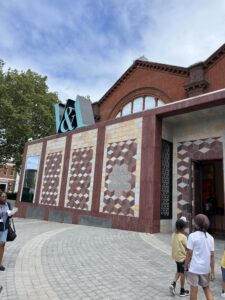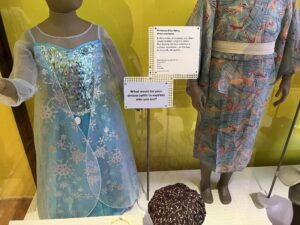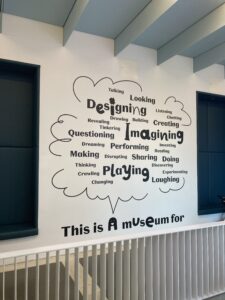Located just moments away from Bethnal Green tube station in East London, the Young V&A has recently reopened after a £13 million make over. The Young V&A is a children’s museum aimed at ages 0 – 14 years and is free to enter for all ages (even adults!).
Although in separate locations the Young V&A is a branch of the main Victoria and Albert Museum (V&A) located in South Kensington.
The Young V&A houses over 2000 permanent objects relating to art, design and performance which relate specifically to young people and also draws on aspects of the vast collection housed at the main V&A site and sparks creativity and imagination of young people.
At the core of the redevelopment is the idea children need to develop creativity skills including the skills of problem solving and collaboration in order to deal with technological changes and environmental issues in the future.
Young V&A hopes that creativity can be developed by sparking children’s curiosity through being able to play, imagine and design! Their newly developed spaces and collection allow children and young people to be creative.

The Young V&A is divided into the three galleries’: Play, Imagine and Design. I immediately felt like the children were welcome and most definitely the VIPS.
Providing a good first impression and creating a welcome environment helps people feel that museums are places for them, it ensures their emotional and social needs are met allowing them to feel ready to engage with the objects.
Promote Talk
Across the museum it was clear to see that many of the spaces and exhibitions were designed with social interaction in mind. Particularly children to adult conversations.
Social interaction and conversations helps young people to develop cognitive process, such as acquiring new language and to make meaning with objects and experiences they have. I could see that across the museum there were questions dispersed though the objects, to help support creating these conversations.
In the Imagine Gallery there were to types of questions used throughout. The first type of questions were ‘imagine, adventure/story building’ questions. They were used across the gallery to inspire children to create their own story using the museum objects displayed in the cabinets underneath. Examples of these questions where “Who are you going to meet?” or ” Where are you going to go?”.
The second type of questions were more personal relevance questions. These questions invited children to make their own personal links and spark discussion using the museum objects as a tool to help guide them. Examples of these questions were “Do you collect anything? Why is it special to you?” and ” What would be your dream outfit to express who you are?”
Throughout the Play Gallery but across the museum I noticed that there were also objects that were specific to the adults childhoods.
I noticed that this sparked some nostalgia among adults which in turn lead to conversations with their children down memory lane explaining how things have changed since they were little.
By encouraging families and groups to talk about what they see , not only do children feel more comfortable expressing and sharing ideas they can see the relevance this has to their lives.
Build confidence and ownership
There was no set route around the museum. Although it had a very traditional gallery format it was disrupted with lots of opportunities for children to play. Some play areas were structured with tasks for children to complete. Where as others were spaces for free unstructured play with toys such as foam blocks and sand tables.
My particular favorite was the stage complete with dress up box which was very popular with the children with lots of characters and stories coming to life.
This allowed for a very child lead approach and may have been the reason why not maps are given out at the entrance.
It allowed children to explore the museum in anyway they want. Giving children the confidence and ownership to explore and discover at their own pace.
There was also a sense that you did not need any prior knowledge before coming to the museum as every exhibit allowed all audiences (including adults) an opportunity to get hands on. By ensuring that no prior knowledge is needed it allowed young people and families to fully enjoy what’s on offer!
BUILD ON KNOWLEDGE
I was struck by the fact that objects ad artifacts are displayed in ways very different to ‘traditional’ museums. In the Play Gallery, for example, objects were displayed in two ways either by colour or alphabetically.
This is a really good way of helping children build on the knowledge they may be learning or have learnt. For example, within the blue cabinet there were a variety of objects both familiar such as Thomas the tank engine and unfamiliar to children.
By having this mix, it would grab children’s attention to the familiar object but get them introduced to new objects which in turn would spark a conversation between adult and child.
Under 3s
Within the Play Gallery there was a specific section for the under 3s entitled the Mini Museum. This space is designed for the youngest visitors. It has tactile floors, tunnels, a sensory area and seating.
What surprised me was that this area had objects in it, although the objects were in cases the children could get right up close and engage with this objects in a safe way.
This ensured that even the youngest visitors could still be included in the traditional museum style. I really liked this aspect of the museum because it felt that they were trying to ensure families with children of varying age could attend the museum but enjoy different aspects of it.
Reflection
I was struck by the fact the museum was genuinely designed for children. It was a space where children could be as loud as they liked, could run around, build, play and learn. The Young V&A said that “The museum will be designed with – and for – the young” and they really did meet this brief.
Our Early Years blog series shares insights from the research, development, and delivery of our work across the Science Museum Group with early years audiences.
What to read next
If you’ve enjoyed this blog post here are others, we recommend you read next…